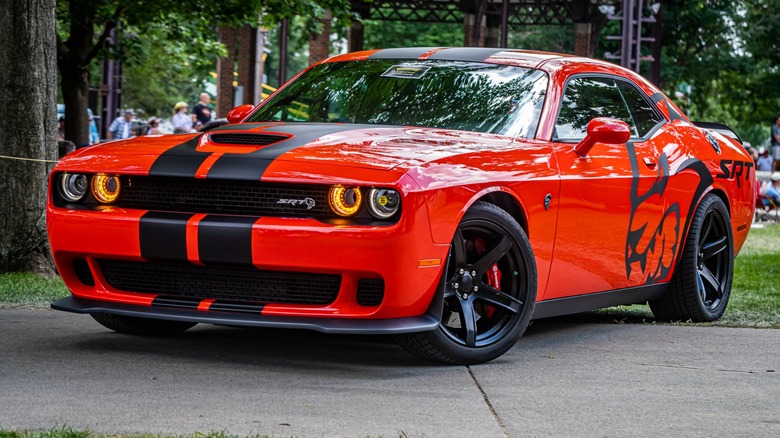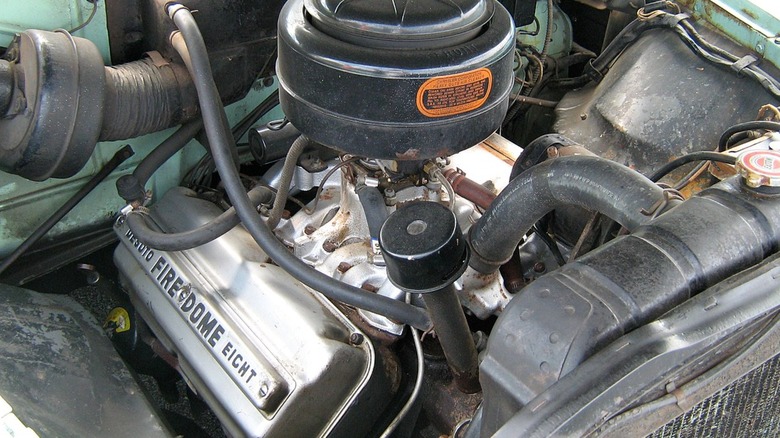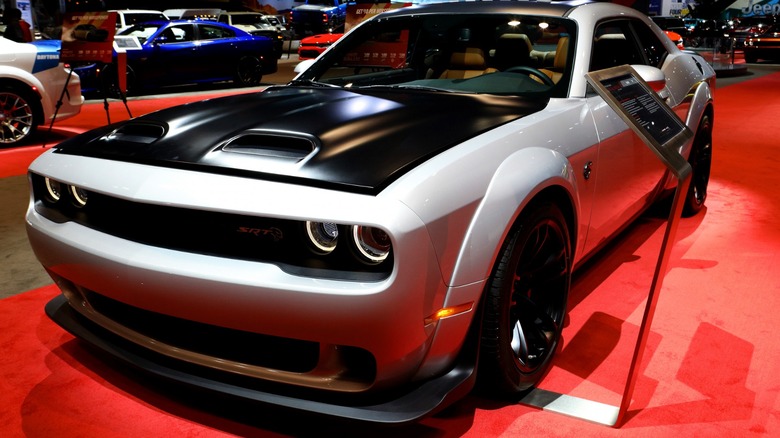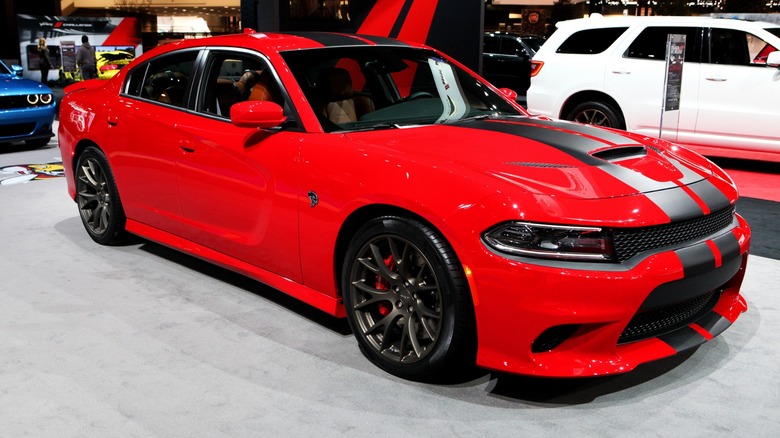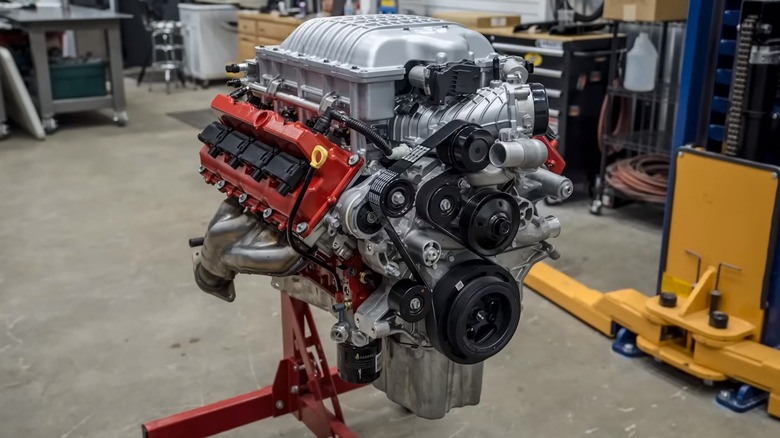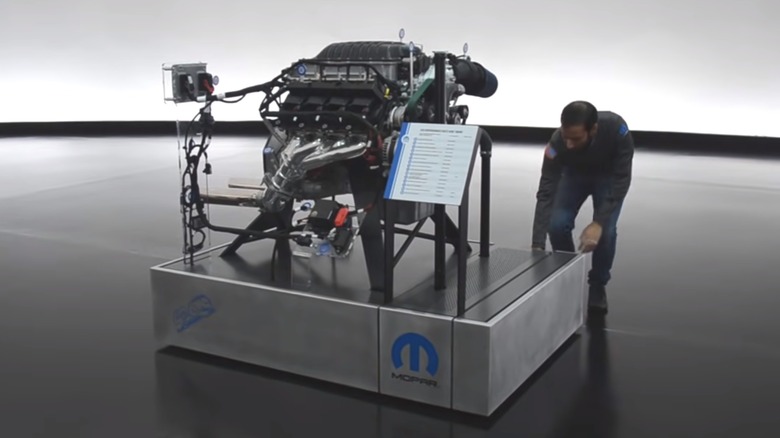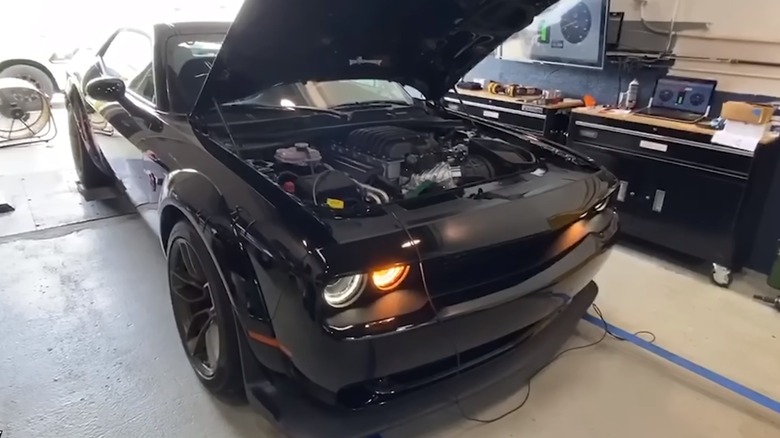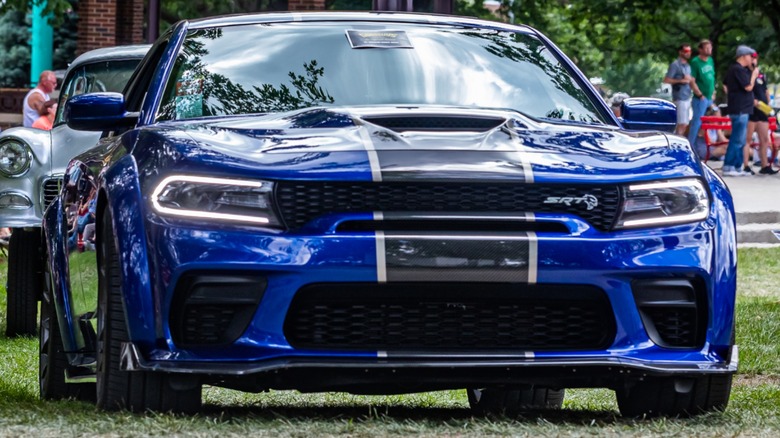Everything You Need To Know About Dodge's Hellcat & Hellephant Engines
The Hemi V8 engine from Chrysler is both legendary and iconic as a part of American automotive history. The Hemi moniker is well-known and its association with Dodge, Chrysler, and Plymouth is as strong as apple pie is to America itself. Most fans of classic American muscle know about the Hemi engines that powered some of the legends of NASCAR and the most popular Mopar muscle cars tearing it up in street races from the 1960s through to the modern day.
There was a time when other automakers created special cars, such as Ford's Boss Mustang 429, to keep up with the Chrysler Hemi cars on the track, and some of those same Hemi-powered cars today can be worth millions. Through the late '60s to early '70s, it seems Chrysler almost owed its existence to the Hemi engine. While that may be hyperbole, its effect on car culture cannot be overstated. But today, Chrysler has rekindled that sort of flame with its latest big-power Hemi engines in its Hellcat and Hellephant V8. These engines are special with power output that feels almost supernatural. Regardless of any notions of otherworldly power, the Hellcat and Hellephant are quite real, and this is all you need to know about both of them.
Hemi history
At the heart of a Chrysler Hemi engine is a combustion chamber with a hemispherical shape, which is where the name is derived. The earliest examples of this feature go back to a Belgian carmaker in 1905 and a Fiat race car in 1907. It is not unique to Chrysler but the company has widely capitalized on the design in its marketing. The origins of the Chrysler Hemi stem from wartime engine development for tanks and fighter planes during WWII, but the first consumer models debuted in the post-war period and debuted in consumer models in 1951.
The hemispherical combustion chamber is mated to domed pistons extending beyond the top of the cylinders, allowing for the spark plug to be placed directly on top of the piston, shortening the overall burn time. Furthermore, this also allows for larger valve sizes that can handle increased airflow but cause the heads to be extremely large compared to other V8 engines. The other advantage is the possibility of higher compression ratios, which also increases power output. Unfortunately, this is more expensive to build and generally confined to high-output engines.
Chrysler used its Hemi engines to sell cars and win races throughout the '60s and into the early '70s. The legendary 426 Hemi was gone by 1973 but the technology was revived again in the new millennium when Chrysler led a push for a new breed of muscle cars driven by big and powerful V8 engines. This, in turn, led to the creation of the Hellcat and Hellephant engines we know today.
Hellcat introduction
Dodge released a new Hemi engine with its 5.7-liter V8 in 2003, ending a 30-year hiatus. Although it was initially only for trucks, that changed as it spread into SRT models of the popular Challenger and Charger. Variable valve trimming came in 2009 as horsepower steadily increased. However, it was the 2015 model year in which the first Hellcat version appeared. By that time, SRT model Dodge and Chrysler vehicles were already boasting about their horsepower ratings near 500, but the Hellcat would introduce a new era of American horsepower.
The 2015 Dodge Challenger SRT Hellcat, named after the American WWII Grumman F6F Hellcat fighter plane, burst onto the scene with an enormous output of 707 horsepower. Thanks to a massive supercharger placed atop the engine, a Dodge had been claimed to have the highest power output of a production car, excluding only niche low-volume supercars like Koenigsegg or Bugatti. Those who purchased a Hellcat received a supercharged 6.2-liter V8 engine paired to either a six-speed manual or eight-speed automatic that could launch the car to 60 mph in just 3.5 seconds while finishing the quarter-mile in only 11.2. Dodge had truly revived the muscle car with this model.
Hellcat specifications and models
To create such incredible power, Dodge added a 2.4-liter twin-screw supercharger capable of providing 12 pounds of boost to the engine. The block is iron and comes with a forged steel crankshaft and powder-forged connecting rods to handle the intense pressures. Forged aluminum pistons with graphite-coated skirts and a first compression ring with PVD coating handle compression duties. Air is drawn through Chrysler's largest throttle body (92 millimeters), and the supercharger directs it through a pair of charge coolers cooling the air by as much as 65 degrees before entering the heads. The long and short of it is that Dodge has upgraded and modified pretty much everything to make its Hellcat Hemi.
While the Challenger SRT Hellcat was the first car introduced with this engine, it was also offered in the Charger that year and in several others in subsequent model years, including a couple of Jeeps. All of them offer around the same 707 horsepower except for a few extra special Challengers. The power rose with the SRT Demon to 840 horsepower in 2019 but fell to 797 in the Hellcat Redeye the next year. The SRT Super Stock brought things back up to 807 horsepower, but went a bit off the charts with the 2023 Demon 170, which offered power of up to an incredible (and not wholly sane) 1,025 horsepower when dueled up with E85 gasoline.
Even on standard pump gas, output remained astonishing at 900 horsepower, so either way, the Demon 170 pushed way past the limits of good taste for any road-legal automobile.
How did Dodge do this?
With all of the high-strength components of the Hellcat engine combined with several peripheral accessories, Dodge's engineers found a formula for brute power exceeding anything imaginable with the 426 Hemi of the late '60s. Besides the forged components and other high-strength features, clever engineering uses some basic physics to squeeze out more power.
The Hellcat is built to a 6.2-liter displacement instead of the 6.4 liters of the SRT Apache engine. This is accomplished using a shorter stroke, which allowed engineers to add material to the tops of the pistons that increased compression while adding strength to handle the added pressure from forced induction. The heads are not modified much from the base Apache heads, although sodium-filled valves that can withstand extraordinary temperatures and disperse heat effectively are used.
Compressed air from the supercharger flows almost directly into the engine, passing through air-to-water charge coolers integrated into both sides of the plenum. Heat exchangers for that fluid are located right behind the bumper to take advantage of high airflow for efficient cooling. The most amazing feature, found in the Demon 170, is Dodge's novel Power Chiller. This takes the integrated charge coolers to another level by using the air conditioning system to cool the liquid in the charge coolers even further after it has passed through the heat exchangers, providing extraordinarily cool and compressed air directly into each combustion chamber. It is the first and only production car to be sold with such a system.
1,025 horsepower is not enough?
For anyone who thinks 900 horsepower on regular pump gas or 1,025 on E85 just is not quite enough power for you, Dodge has you covered with its Hellephant engine. Built using most of the same components and to the same specification as the Hellcat, the Hellephant increases displacement to seven liters.
You might think this is just absurd, and that seven liters, which matches the displacement of the classic 426 Hemi, is just plain overkill. The absurdity is valid; you would not be able to drive a car on the street using this engine as it is sold only as a crate engine with explicit directions to use it only on the race track as it is not EPA-certified for highway use. Like the Hellcat engine, E85 is required to hit the top power potential of around 1,100 horsepower. One thing you might notice is that this power is not significantly higher than in the Demon 170, but it is rated for the engine and does not necessarily have the Power Chiller. This increase comes from good old-fashioned displacement.
This and other crate engines are available from Direct Connection, which is a part of Dodge. A Direct Connection 1500 HEMI is also available if you need 1,500 horsepower. One more thing to know is that you will need nearly $30,000 to buy a Hellephant, so you better be serious about it.
Where to drive a Hellephant-equipped car
At this time, it's better to not tempt fate by swapping your Challenger's engine just yet, as buyers could incur hefty fines if caught driving with one on the streets. However, despite the enormous cost, many fine folks have already bought and installed a few of these crate monsters.
Road and Track reported about AJ Berge from Hemituner Performance, who took his Hellephant-equipped Challenger to the drag strip to see what it could do. With his freshly installed Hemi and some super sticky drag slicks prepped on the rear, he managed to pull an impressive time of 9.278 seconds at 150 mph, a full second quicker than a stock Demon 170. Around the same time, Car and Driver wrote about the Demonology YouTube channel taking its Hellephant-swapped SRT Demon to the dyno. The results came in with 944 horsepower and 877 lb-ft of torque, representing only a 6% loss based on the stated rating of 1,000 horsepower. It does not mention which fuel was used.
Future of Hemi power
With increasingly stringent emissions regulations and the proliferation of electric propulsion, it appears that Hemi is not long for this world. Dodge announced that it will be moving toward electrification of its traditional muscle car models and its V8 engines are being phased out. Even the 2025 Ram trucks will only be offered with the new Hurricane twin-turbo straight-six engine. That is not all too bad as that engine offers an extremely generous 540 horsepower. The V8 will only be missed due to nostalgia rather than a rational assessment.
Direct Connection announced crate versions of the Hurricane engine called HurriCrate in 2023. As of now, it appears crate versions of the Hemi and Hurricane engines will continue to be available, but there's no telling how long that will last. Regardless, the days of the Hellcat and Hellephant already closing as Hemi development for production passenger cars comes to a close. Those who were lucky enough to have bought one now have rare cars that are virtually guaranteed future classics. Indeed the days of gasoline-powered big horsepower days are over, but power and speed will remain as long as people are willing to buy it.
